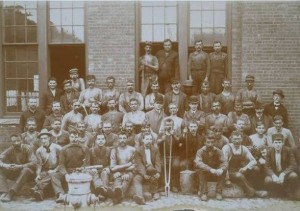Immigration to Connecticut in the second half of the 19th century proceeded much as it had in earlier decades. Driven from their homelands by changing social and economic conditions, waves of primarily European immigrants arrived in Connecticut and increasingly found homes in industrial cities. What distinguished immigration later in the century, however, was the vastly increased numbers of new arrivals to the state, the variety of population centers from which they departed, and the growing hostility they faced upon arrival.
In the 1850s, Connecticut’s roughly 38,000 immigrants made up approximately 10 percent of the state’s population. Most of these immigrants came from northern and western Europe, with the largest number arriving from Ireland. By 1870, more than half the immigrants living in Connecticut were Irish. A dramatic shift late in the century, however, soon reshaped Connecticut’s ethnic identity.

Extra! Der hartforder Stadt-Bote.Hartforder Stadt-Bote, 1882 – Broadside listing all the names running on the German Independent Ticket – Connecticut Historical Society and Connecticut History Illustrated
European Immigration Boom
A population explosion in the southern and eastern regions of Europe, coupled with improvements to railroad, steamship, and transoceanic transportation, soon brought waves of immigrants from Italy, Poland, and the areas in and around Austria-Hungary. This “new” immigration contained large numbers of single males who came in search of work. As the demand for unskilled labor grew in the Northeast, foreign workers increasingly found employment in industrial centers. Toward the end of the century, work as a “laborer” became the primary occupation for the Polish, Italian, Greek, Slovenian, Lithuanian, Serbian, and Bulgarian immigrants in the Northeast. While immigrants from around the world found new homes throughout Connecticut, the draw of particular regional immigrant networks promoted the growth of new ethnic neighborhoods in major cities such as New Haven, New London, and Bridgeport.
Hartford drew a large population of German immigrants. Beginning their arrival in the 1850s, by the end of the century the German population made up over 10 percent of all Hartford residents and was the fastest growing immigrant group in the city. Known in particular for their skill in manufacturing furniture, Hartford Germans played a significant role in the city’s domestic, political, and commercial maturation.
Large numbers of Polish immigrants also arrived in Connecticut during this period, giving Connecticut the highest ratio of Polish to native-born residents in the United States. While drawn to opportunities throughout the state, enough settled into industries in New Britain to eventually earn the city the nickname, “Little Poland.”
At the end of the century, Italians became the largest immigrant group in Connecticut, surpassing the Irish. Motivated to leave Italy by high taxation and a series of agricultural catastrophes, many of these arrivals initially found work as unskilled laborers. Like many newcomers, they settled into large cities such as Hartford and New Haven, but they increasingly found employment alongside Russians, Lithuanians, and Germans in the brass mills of Waterbury—eventually becoming the most prolific immigrant population in the city.

Casting shop employees, Benedict & Burnham Manufacturing Company, ca. 1901, Waterbury – Archives & Special Collections of the University of Connecticut Libraries, and Connecticut History Illustrated
These arrivals coincided with other similar movements in Connecticut that witnessed, among other settlements, the movement of substantial Hungarian and Ukrainian populations to the southern and western portions of the state. It was also a period characterized by the arrival of large numbers of European Jews seeking both economic opportunity and relief from religious persecution.
Despite Anti-immigration Sentiments, Newcomers Find a Place in Connecticut
In addition to their larger numbers and more diverse national origins, immigrants new to Connecticut in the latter part of the 19th century also faced increased resistance to their arrival. While many of the state’s industries were in favor of having a large supply of cheap labor to fill their factories, immigrants who arrived in prior decades often resented the presence of new competition for jobs. Also, the general population feared the challenges these newcomers posed to the preservation of their traditional way of life. In a meeting of the Connecticut Congregational Club on March 21, 1893, MIT president General Francis A. Walker called on the government to tighten immigration restrictions to stop the “pollution of the natives.”
Despite these challenges, immigration to Connecticut exploded in the latter part of the 19th century. While immigrants made up roughly 10 percent of all Connecticut residents in 1850, by 1870 that number reached 25 percent, and by 1900, approximately 20,000 new immigrants were arriving in the state every year. By the turn of the century, Connecticut had one of the highest percentages of foreign-born residents in the country.

A group of Italian immigrants attending a class in English language, ca. 1890-1910 – Archives & Special Collections of the University of Connecticut Libraries, and Connecticut History Illustrated









